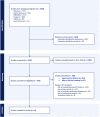The impact of interprofessional collaboration between pharmacists and community health workers on medication adherence: a systematic review
- PMID: 40022158
- PMCID: PMC11869407
- DOI: 10.1186/s12939-025-02415-4
The impact of interprofessional collaboration between pharmacists and community health workers on medication adherence: a systematic review
Abstract
Background: There is increasing evidence to support the effectiveness of interventions involving community health workers (CHWs) in improving patient health outcomes, which reinforces their growing integration in healthcare teams. However, little is known about the interprofessional collaboration between pharmacists and CHWs. This systematic review aimed to explore the impact of interprofessional interventions involving pharmacists and CHWs on patient medication adherence.
Methods: The English language scientific literature published in Embase, MEDLINE, Web of Science, CINAHL, Scopus, plus the grey literature were searched in October 2024. Using the software Covidence, two authors screened article titles and abstracts and assessed full-text articles for eligibility. Studies were included if (i) the intervention was delivered by pharmacists and CHWs and (ii) reported on medication adherence outcomes. Data were extracted using a customized template using Excel and synthetized narratively. The Effective Public Health Practice Project quality assessment tool was used to assess the studies' methodological quality.
Results: Eight studies met the inclusion criteria, including a total of 1577 participants. Seven studies were conducted in the United States, and six were published since 2020. The interventions consisted of medication therapy management, medication reconciliation, and repeated education sessions. The CHW shared clinical and non-clinical patient information and ensured a culturally safe environment while the pharmacist delivered the clinical intervention. In five studies, medication adherence was evaluated solely through patient self-reported measures. One study used an objective measure (i.e., pharmacy refill records) to evaluate medication adherence. Only two studies assessed medication adherence using both self-reported and objective measures (i.e., pill count and proportion of days covered). A significant improvement in medication adherence was observed in three of the eight studies. Half of the studies were of weak quality and half of moderate quality.
Conclusions: There was a small number of studies identified which focused on the impact of interprofessional collaboration between pharmacists and CHWs on medication adherence. The impact of the interprofessional interventions on medication adherence was limited. Further studies of higher quality are needed to better evaluate the impact of such collaboration on patient health outcomes.
Registration: PROSPERO, ID CRD42024526969.
Keywords: Community health navigators; Community health workers; Compliance; Health coaches; Interprofessional collaboration; Medication adherence; Multidisciplinary healthcare teams; Navigators; Pharmacists; Promotoras.
© 2025. The Author(s).
Conflict of interest statement
Declarations. Ethics approval and consent to participate: Not applicable. Consent for publication: Not applicable. Competing interests: The authors declare no competing interests.
Figures
Similar articles
-
Interprofessional collaboration between pharmacists and community health workers: a scoping review.Int J Equity Health. 2025 Jan 21;24(1):23. doi: 10.1186/s12939-025-02377-7. Int J Equity Health. 2025. PMID: 39838436 Free PMC article.
-
Beyond the black stump: rapid reviews of health research issues affecting regional, rural and remote Australia.Med J Aust. 2020 Dec;213 Suppl 11:S3-S32.e1. doi: 10.5694/mja2.50881. Med J Aust. 2020. PMID: 33314144
-
An assessment of pharmacist perceptions and experiences with community health workers.J Am Pharm Assoc (2003). 2024 Jul-Aug;64(4S):102112. doi: 10.1016/j.japh.2024.102112. Epub 2024 May 3. J Am Pharm Assoc (2003). 2024. PMID: 38705469
-
Qualitative study to conceptualise a model of interprofessional collaboration between pharmacists and general practitioners to support patients' adherence to medication.BMJ Open. 2016 Mar 16;6(3):e010488. doi: 10.1136/bmjopen-2015-010488. BMJ Open. 2016. PMID: 26983948 Free PMC article.
-
Interventions for improving medication-taking ability and adherence in older adults prescribed multiple medications.Cochrane Database Syst Rev. 2020 May 8;5(5):CD012419. doi: 10.1002/14651858.CD012419.pub2. Cochrane Database Syst Rev. 2020. PMID: 32383493 Free PMC article.
Cited by
-
Social Support's Dual Mechanisms in the Loneliness-Frailty Link Among Older Adults with Diabetes in Beijing: A Cross-Sectional Study of Mediation and Moderation.Healthcare (Basel). 2025 Jul 16;13(14):1713. doi: 10.3390/healthcare13141713. Healthcare (Basel). 2025. PMID: 40724738 Free PMC article.
-
Enhancing the Role of Community Pharmacists in Medication Safety: A Qualitative Study of Voices from the Frontline.Pharmacy (Basel). 2025 Jul 9;13(4):94. doi: 10.3390/pharmacy13040094. Pharmacy (Basel). 2025. PMID: 40700265 Free PMC article.
References
-
- Vrijens B, De Geest S, Hughes DA, Przemyslaw K, Demonceau J, Ruppar T, Dobbels F, Fargher E, Morrison V, Lewek P, Matyjaszczyk M, Mshelia C, Clyne W, Aronson JK, Urquhart J, Team ABCP. A new taxonomy for describing and defining adherence to medications. Br J Clin Pharmacol. 2012;73(5):691–705. - PMC - PubMed
-
- Sabate E. Adherence to long-term therapies: evidence for action. Geneva: World Health Organization (WHO). 2003.
-
- Khan R, Socha-Dietrich K. Investing in medication adherence improves health outcomes and health system efficiency. Paris: OECD Publishing; 2018.
-
- Glass TR, Sterne JA, Schneider MP, De Geest S, Nicca D, Furrer H, Günthard HF, Bernasconi E, Calmy A, Rickenbach M, Battegay M, Bucher HC. Self-reported nonadherence to antiretroviral therapy as a predictor of viral failure and mortality. Aids. 2015;29(16):2195–200. - PubMed
Publication types
MeSH terms
Grants and funding
LinkOut - more resources
Full Text Sources
Miscellaneous


